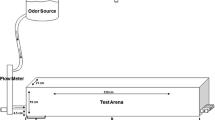Abstract
Fish mediate many biological processes by olfaction, which can be impaired by contaminants (i.e. metals). While the olfactory recovery of fish from metal contaminated lakes if subsequently cultured in clean water has been shown at the neurophysiological level, the recovery potential of olfactory mediated behaviours remains unknown. To study behavioural recovery of fish from metal contaminated lakes, wild yellow perch (Perca flavescens) were collected from two metal-contaminated lakes (Ramsey and Hannah lakes) in the metal-mining district of Sudbury, ON, Canada and cultured in clean water from a reference lake (Geneva Lake) for another 24 h. Olfactory mediated behaviours of the test organisms were tested using avoidance responses to conspecific skin extract. While olfactory mediated behaviours of fish from Ramsey Lake (low contamination) recovered after 24 h in clean water, recovery could not be observed in fish from Hannah Lake (high contamination). These results demonstrate that the recovery of behavioural deficits of fish from metal contaminated lakes is depending on the habitats’ metal concentration.

Similar content being viewed by others
References
Azizishirazi A, Dew WA, Forsyth HL, Pyle GG (2013) Olfactory recovery of wild yellow perch from metal contaminated lakes. Ecotoxicol Environ Saf 88:42–47. doi:10.1016/j.ecoenv.2012.10.015
Azizishirazi A, Dew WA, Bougas B, Dashtban M, Bernatchez L, Pyle GG (2014) Chemosensory mediated behaviors and gene transcription profiles in wild yellow perch (Perca flavescens) from metal contaminated lakes. Ecotoxicol Environ Saf 106:239–245. doi:10.1016/j.ecoenv.2014.04.045
Baldwin DH, Sandahl JF, Labenia JS, Scholz NL (2003) Sublethal effects of copper on coho salmon: impacts on non-overlapping receptor pathways in the peripheral olfactory nervous system. Environ Toxicol Chem 22:2266–2274. doi:10.1897/02-428
Bettini S, Ciani F, Franceschini V (2006) Recovery of the olfactory receptor neurons in the African Tilapia mariae following exposure to low copper level. Aquat Toxicol 76:321–328. doi:10.1016/j.aquatox.2005.10.009
Couture P, Pyle G (2012) Field studies on metal accumulation and effects in fish. In: Wood CM, Farrell AP, Baruner CJ (eds) Homeostasis and toxicology of essential metals. Elsevier, Amsterdam, pp 417–473
Dew WA, Wood CM, Pyle GG (2012) Effects of continuous copper exposure and calcium on the olfactory response of fathead minnows. Environ Sci Technol 46:9019–9026. doi:10.1021/es300670p
Dew WA, Azizishirazi A, Pyle GG (2014) Contaminant-specific targeting of olfactory sensory neuron classes: connecting neuron class impairment with behavioural deficits. Chemosphere 112:519–525. doi:10.1016/j.chemosphere.2014.02.047
Døving KB, Lastein S (2009) The alarm reaction in fishes—odorants, modulations of responses, neural pathways. Ann NY Acad Sci 1170:413–423. doi:10.1111/j.1749-6632.2009.04111.x
Erickson RJ, Benoit DA, Mattson VR, Leonard EN, Nelson HP (1996) The effects of water chemistry on the toxicity of copper to fathead minnows. Environ Toxicol Chem 15:181–193. doi:10.1002/etc.562015021
Green WW, Mirza RS, Wood C, Pyle G (2010) Copper binding dynamics and olfactory impairment in fathead minnows (Pimephales promelas). Environ Sci Technol 44:1431–1437. doi:10.1021/es9023892
Hara TJ (2006) Feeding behaviour in some teleosts is triggered by single amino acids primarily through olfaction. J Fish Biol 68:810–825. doi:10.1111/j.0022-1112.2006.00967.x
Keller W, Yan ND, Gunn JM, Heneberry J (2007) Recovery of acidified lakes: lessons from Sudbury, Ontario, Canada. Water Air Soil Pollut 7:317–322I. doi:10.1007/s11267-006-9061-2
Kolmakov NN, Hubbard PC, Lopes O, Canario AVM (2009) Effect of acute copper sulfate exposure on olfactory responses to amino acids and pheromones in goldfish (Carassius auratus). Environ Sci Technol 43:8393–8399. doi:10.1021/es901166m
Mirza RS, Green WW, Connor S, Weeks AC, Wood CM, Pyle GG (2009) Do you smell what i smell? Olfactory impairment in wild yellow perch from metal-contaminated waters. Ecotoxicol Environ Saf 72:677–683. doi:10.1016/j.ecoenv.2008.10.001
Pyle GG, Rajotte JW, Couture P (2005) Effects of industrial metals on wild fish populations along a metal contamination gradient. Ecotoxicol Environ Saf 61:287–312. doi:10.1016/j.ecoenv.2004.09.003
Sandahl JF, Miyasaka G, Koide N, Ueda H (2006) Olfactory inhibition and recovery in chum salmon (Oncorhynchus keta) following copper exposure. Can J Fish Aquat Sci 63:1840–1847. doi:10.1139/f06-074
R Development Core Team 2012. R: a language and environment for statistical computing. R Foundation for statistical computing, Vienna, Austria. ISBN 3-900051-07-0, URL http://www.R-project.org/
Tierney KB, Baldwin DH, Hara TJ, Ross PS, Scholz NL, Kennedy CJ (2010) Olfactory toxicity in fishes. Aquat Toxicol 96:2–26. doi:10.1016/j.aquatox.2009.09.019
Yambe H, Kitamura S, Kamio M, Yamada M, Matsunaga S, Fusetani N, Yamazaki F (2006) L-Kynurenine, an amino acid identified as a sex pheromone in the urine of ovulated female masu salmon. Proc Natl Acad Sci USA 103:15370–15374. doi:10.1073/pnas.0604340103
Acknowledgments
Authors would like to thank Dr. John Gunn and the personnel of the Cooperative Freshwater Ecology Unit, Sudbury, ON for their support. In addition, we thank Anne Willis for her help in conducting this experiment and Patrick Gauthier for reviewing this manuscript. Funding for this study was provided by a research grant from the Natural Science and Engineering Research of Canada (NSERC Collaborative Research and Development grant program) with complementary funding from Vale Canada Limited. GGP was supported by the Canada Research Chairs program during the field portion of this research, and is currently supported by a Campus Alberta Innovates Program (CAIP) Chair in Aquatic Health.
Author information
Authors and Affiliations
Corresponding author
Rights and permissions
About this article
Cite this article
Azizishirazi, A., Pyle, G.G. Recovery of Olfactory Mediated Behaviours of Fish from Metal Contaminated Lakes. Bull Environ Contam Toxicol 95, 1–5 (2015). https://doi.org/10.1007/s00128-015-1460-5
Received:
Accepted:
Published:
Issue Date:
DOI: https://doi.org/10.1007/s00128-015-1460-5




